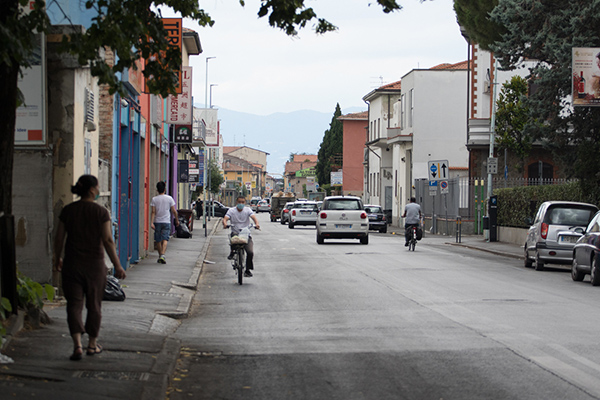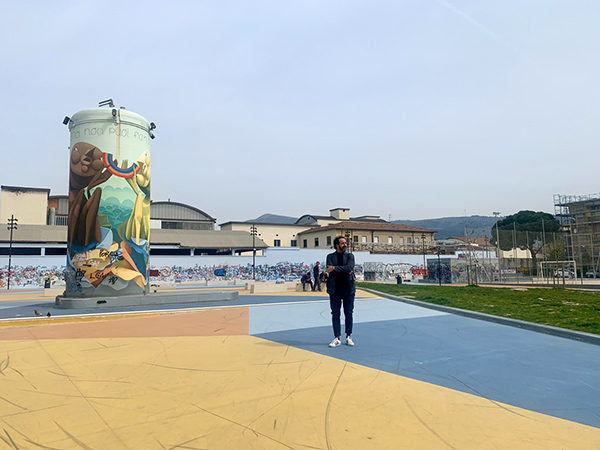Create social cohesion by urban renovation: Macrolotto Zero project
In Italy, a former industrial district is changing. Metropolitan market and urban jungles replace wastelands and idle factories, to improve the daily life of the inhabitants and allow them to live better together.

Prato (Italy)
«We’re in Fabrica Forti - in the southern part of the district, a former textile factory, settled near a water flow canal - the textile industry is dependent on water in virtually all steps of manufacturing - that will become a hub for social and commercial activities», says Valerio Barberis, Deputy Mayor for Urban Planning and Environment of Prato. We meet him in the building site of Metropolitan Market in Giordano str. in Macrolotto zero, a district of 44 hectares, directly west of the historic city centre. A mixed-purpose area that is being transformed through a larger project of urban regeneration.
The Macrolotto 0 aims to represent an alternative model of integrated urban planning in which attention to sustainability, ethic and aesthetic of urban, is combined with the search for socially inclusive solutions and multicultural coexistence. Due to its past as the largest textile hub in Europe, the district, in fact, has been marked by decades of Chinese migration flows that have reshaped the economic and social “fabric” of the neighborhood. The urban tissue is now mainly characterized by a large number of densely settled industrial sheds and wharehouses.

Between the early 1990s and the beginning of the third millennium, the number of firms set up by immigrants has increased greatly and the Macrolotto 0 - more commonly referred to as ‘Chinatown’ - is now arguably one of the biggest multicultural urban contexts in Italy and more generally in Europe (after Paris and London).
A lack of public spaces
«The problem is not that is a multicultural district the problem is the lack of public spaces», declares Barberis. This massive Chinese presence, in fact, has changed the character of the area to such an extent as to render it foreign to long-term residents. «Especially in the past, we had to face strong problem in term of cohabitation between elderly Italian citizens and Chinese community». The inhabitants of Via Pistoiese, in particular, protested about community issues and strained relations due to the concentration of Chinese.
The urban strategy carried on by Comune di Prato is focused on the redevelopment of the area which is affected by social issues and need spaces for aggregation through a participatory and sustainable action.
The project of the Municipality is to renew the district in a sustainable and inclusive way by developing areas of high green density - the so-called Urban Jungles - that will be grafted into the urban landscape by multiplying the natural ability of plants to break down the substances pollutants, and returning the territory to the use of people, transforming the areas of marginality into real points of green well-being within the city.
The new playground, built in an abandoned industrial area, for example, has been interested by a program that merges socialization needs with physical activities to raise the quality of public life.

Through the PIU project, funded by the ERDF (for urban, cultural and social innovation areas), the municipality is trying to make the multicultural district more liveable, socially attractive and economically viable. This concept has been also expanded into a 3.8-million euro, EU-funded project through the Urban Innovative Actions call.
From “factory city” to Creative District
«There are four pillars that shapes the urban policies of a city: environmental transition; digital transition; circular urban metabolism, inclusion and social equity», says Barberis, explaining the choice of the municipality to pursuit a “holistic approach” in the redevelopment of the district. Having a holistic approach means looking at something as a whole interconnected entity in a way that is replicable in the redevelopment of a city.
The Fabrica Forti, in fact, will host a metropolitan market and spaces for workshops. «What we’re doing here is reuse an existing building, introducing natural based solution, reducing the chain of sustainability and open the spaces to a more participatory process».

In the ex-warehouses, the neurobiologist Stefano Mancuso and his team at PNAT, a spin-off of the University of Florence’s plant neurobiology, will build also the largest green air filter in Europe.
The goal is to see the city and its residents rethink consumption, optimize production cycles and increase social inclusion in an ever more circular city. «Regarding the digital transition, the Media Library, a co-working place, will host Prisma (PRato Industrial SMart Accelerator) a competence center where mix together research, startups..», continues Barberis.
The PRISMA project aims to create a new technology transfer infrastructure to investigate the innovative potential of emerging technologies applied to fashion, favoring the creation and acceleration of new companies in this area. The new municipal plan wants to transform this controversial district in a completely new “creative” district in order to be more attractive for investors and creative people.
Redevelopment through participatory process: Co-design
The redevelopment of the district has successfully relied on the participation of the citizens in the transformation of their neighborhood. The Urban Jungles, in fact, have been co-designed with the help of citizens, through shared urban planning, which opened the management to the community, increasing inclusiveness and favoring the widespread sustainable development of the urban environment.
The Toscana Co-design, a multidisciplinary network of experts in the planning of co-design paths, through the Junglathon project, has been involved in promoting co-design practices, human centered. «Junglathons are activities that pursue the goal of gathering insights, opportunities, needs, ideas that emerge from the locals», said Andrea Del Bono

The Junglathon pathway consists of 3 phases: research and involvement with the aim of bringing out the needs and expectations of citizens, through surveys, directing subsequent activities and involving all stakeholders. Co-design and workshop: organization and facilitation of Junglathons, an intensive co-design format with the aim of developing innovative concepts. Testing and definition, with the aim of validating and fine-tuning the concepts emerged from the Junglathons.
The JunglathonLab, 3 days of meetings open to citizens dedicated to the development of innovative ideas, constituted an important moment of imagination and civic innovation. «During our research, we’ve received feedbacks and follow-up especially from very young, educated population, aware of the benefits that nature could bring», continues Andrea. «The big issue, although, was the lack of public space in this area and the reforestation act is linked to that in the attempt to find more place to aggregate and socialize».
The successful transformation of this area has strengthened the determination of local residents and the network of associations to continue improving the district’s safety, counter its decay and raise living standards. «The Prato Urban Jungle ProJet gave the city like a big impulse toward building and creating stuff, in a material and tangible way, but also, in an intangible way, helped the community making, collective creativity, stimulating new sustainable practice and inclusion.»
 This article was produced as part of the Union Is Strength competition, organised by Slate.fr with the financial support of the European Union. The article reflects the views of the author and the European Commission cannot be held responsible for its content or use.
This article was produced as part of the Union Is Strength competition, organised by Slate.fr with the financial support of the European Union. The article reflects the views of the author and the European Commission cannot be held responsible for its content or use.